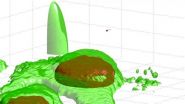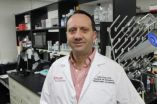(Press-News.org) VIDEO:
"Kiss and run " on the cell surface. This 3-D movie shows actual footage of a virus-like particle (red dot) approaching a cell (green with reddish brown nucleus), as captured by...
Click here for more information.
Tiny and swift, viruses are hard to capture on video. Now researchers at Princeton University have achieved an unprecedented look at a virus-like particle as it tries to break into and infect a cell. The technique they developed could help scientists learn more about how to deliver drugs via nanoparticles — which are about the same size as viruses — as well as how to prevent viral infection from occurring.
The video reveals a virus-like particle zipping around in a rapid, erratic manner until it encounters a cell, bounces and skids along the surface, and either lifts offagain or, in much less time than it takes to blink an eye, slips into the cell's interior. The work was published in Nature Nanotechnology.
"The challenge in imaging these events is that viruses and nanoparticles are small and fast, while cells are relatively large and immobile," said Kevin Welsher, a postdoctoral researcher in Princeton's Department of Chemistry and first author on the study. "That has made it very hard to capture these interactions."
The problem can be compared to shooting video of a hummingbird as it roams around a vast garden, said Haw Yang, associate professor of chemistry and Welsher's adviser. Focus the camera on the fast-moving hummingbird, and the background will be blurred. Focus on the background, and the bird will be blurred.
The researchers solved the problem by using two cameras, one that locked onto the virus-like nanoparticle and followed it faithfully, and another that filmed the cell and surrounding environment.
Putting the two images together yielded a level of detail about the movement of nano-sized particles that has never before been achieved, Yang said. Prior to this work, he said, the only way to see small objects at a similar resolution was to use a technique called electron microscopy, which requires killing the cell.
"What Kevin has done that is really different is that he can capture a three-dimensional view of a virus-sized particle attacking a living cell, whereas electron microscopy is in two-dimensions and on dead cells," Yang said. "This gives us a completely new level of understanding."
In addition to simply viewing the particle's antics, the researchers can use the technique to map the contours of the cell surface, which is bumpy with proteins that push up from beneath the surface. By following the particle's movement along the surface of the cell, the researchers were able to map the protrusions, just as a blind person might use his or her fingers to construct an image of a person's face.
"Following the motion of the particle allowed us to trace very fine structures with a precision of about 10 nanometers, which typically is only available with an electron microscope," Welsher said. (A nanometer is one billionth of a meter and roughly 1000 times smaller than the width of a human hair.) He added that measuring changes in the speed of the particle allowed the researchers to infer the viscosity of the extracellular environment just above the cell surface.
The technology has potential benefits for both drug discovery and basic scientific discovery, Yang said. "We believe this will impact the study of how nanoparticles can deliver medicines to cells, potentially leading to some new lines of defense in antiviral therapies," he said. "For basic research, there are a number of questions that can now be explored, such as how a cell surface receptor interacts with a viral particle or with a drug."
Welsher added that such basic research could lead to new strategies for keeping viruses from entering cells in the first place.
"If we understand what is happening to the virus before it gets to your cells," said Welsher, "then we can think about ways to prevent infection altogether. It is like deflecting missiles before they get there rather than trying to control the damage once you've been hit."
To create the virus-like particle, the researchers coated a miniscule polystyrene ball with quantum dots, which are semiconductor bits that emit light and allow the camera to find the particle. Next, the particle was studded with protein segments known as Tat peptides, derived from the HIV-1 virus, which help the particle find the cell. The width of the final particle was about 100 nanometers.
The researchers then let loose the particles into a dish containing skin cells known as fibroblasts. One camera followed the particle while a second imaging system took pictures of the cell using a technique called laser scanning microscopy, which involves taking multiple images, each in a slightly different focal plane, and combining them to make a three-dimensional picture.
INFORMATION:
Now in 3-D: Video of virus-sized particle trying to enter cell
2014-02-24
ELSE PRESS RELEASES FROM THIS DATE:
Preventive oophorectomy reduces risk of death by 77 percent for women with BRCA mutation
2014-02-24
TORONTO, ON, February 24, 2014 —Women who carry a BRCA gene mutation and opt for a preventive oophorectomy, or ovary removal surgery, have a 77 per cent lower risk of death than those who do not, according to a new study led by Women's College Hospital's Amy Finch and Dr. Steven Narod.
Research has long shown that preventive oophorectomy reduces the risks of ovarian and breast cancers in women with a BRCA gene mutation, but the best age for women to have the surgery and its impact on mortality has not been well studied. The findings by Finch and colleagues, published ...
Study shows preventive ovarian surgery in BRCA1 mutation carriers should be performed early
2014-02-24
The findings of a large international prospective study published in the Journal of Clinical Oncology suggest for the first time that women with BRCA1 mutations should have preventive ovarian surgery (prophylactic oophorectomy) by age 35, as waiting until a later age appears to increase the risk of ovarian cancer before or at the time of the preventive surgery. Women with a BRCA2 mutation, however, do not appear to be at an increased risk by age 35, suggesting they may delay this procedure until later. Moreover, women with BRCA1 and BRCA2 mutations who had this surgery ...
JCI online ahead of print table of contents for Feb. 24, 2014
2014-02-24
Clinical trial assesses anti-FGF23 for treating X-linked hypophosphatemia
X-linked hypophosphatemia (XLH) is a heritable form of rickets that results from mutations in the gene encoding the phosphate regulating endopeptidase (PHEX). Unlike diet-associated forms of rickets, XLH cannot be ameliorated by vitamin D ingestion. XLH patients have increased serum levels of FGF23, which decreases both inorganic phosphate (Pi) and the activated form of vitamin D. In this issue of the Journal of Clinical Investigation, Thomas Carpenter and colleagues at Yale University evaluated ...
Seed dispersal gets a test in carved-out 'habitat corridors'
2014-02-24
MADISON, Wis. — Field ecologists go to great lengths to get data: radio collars and automatic video cameras are only two of their creative techniques for documenting the natural world. So when a group of ecologists set out to see how wind moves seeds through isolated patches of habitat carved into a longleaf pine plantation in South Carolina, they twisted colored yarn to create mock seeds that would drift with the wind much like native seeds.
The "seeds" were dusted with fluorescent powder and inserted into custom-made boxes mounted on poles, then released as the scientists ...
Better livestock diets to combat climate change and improve food security
2014-02-24
Livestock production is responsible for 12% of human-related greenhouse gas emissions, primarily coming from land use change and deforestation caused by expansion of agriculture, as well as methane released by the animals themselves, with a lesser amount coming from manure management and feed production.
“There is a lot of discussion about reduction of meat in the diets as a way to reduce emissions,” says IIASA researcher Petr Havlík, who led the study “But our results show that targeting the production side of agriculture is a much more efficient way to reduce greenhouse ...
Marine algae can sense the rainbow
2014-02-24
A new study published in Proceedings of the National Academy of Sciences has shown for the first time that several types of aquatic algae can detect orange, green and blue light.
Land plants have receptors to detect light on the red and far red of the spectrum, which are the common wavelengths in the air. These plants sense the light to move and grow as their environment changes, for example when another plant shades them from the sun. But in the ocean, the water absorbs red wavelengths, instead reflecting colours such as blue and green. As part of the study, a team of ...
A paper diagnostic for cancer
2014-02-24
CAMBRIDGE, MA -- Cancer rates in developing nations have climbed sharply in recent years, and now account for 70 percent of cancer mortality worldwide. Early detection has been proven to improve outcomes, but screening approaches such as mammograms and colonoscopy, used in the developed world, are too costly to be implemented in settings with little medical infrastructure.
To address this gap, MIT engineers have developed a simple, cheap, paper test that could improve diagnosis rates and help people get treated earlier. The diagnostic, which works much like a pregnancy ...
Species conservation poised to benefit from DNA advances
2014-02-24
A biologist at the University of York is part of an international team which has shown that advanced DNA sequencing technologies can be used to accurately measure the levels of inbreeding in wild animal populations.
The research by senior author Dr Kanchon Dasmahapatra, of the Department of Biology at York, and led by Dr Joseph Hoffman, of the Department of Animal Behaviour, Bielefeld University, Germany, may help efforts to conserve rare species.
Laboratory studies show that inbreeding reduces fitness. However, studying the impact of inbreeding in wild populations has ...
Acupuncture holds promise for treating inflammatory disease
2014-02-24
When acupuncture first became popular in the western hemisphere it had its doubters. It still does. But over time, through detailed observation, scientists have produced real evidence that ancient Chinese practitioners of the medical arts were onto something.
Now new research documents a direct connection between the use of acupuncture and physical processes that could alleviate sepsis, a condition that often develops in hospital intensive care units, springs from infection and inflammation, and takes an estimated 250,000 lives in the United States every year.
"Sepsis ...
New study shows a genetic link between feeding behavior and animal dispersal
2014-02-24
New research from the University of Toronto Scarborough shows that animal dispersal is influenced by a gene associated with feeding and food search behaviours.
The study, which was carried out by UTSC Professor Mark Fitzpatrick and PhD student Allan Edelsparre, provides one of the first aimed at gaining a functional understanding of how genes can influence dispersal tendencies in nature.
Using common fruit flies (Drosophila melanogaster), the researchers observed how two different foraging types – known as sitter flies and rover flies – moved over large distances ...



